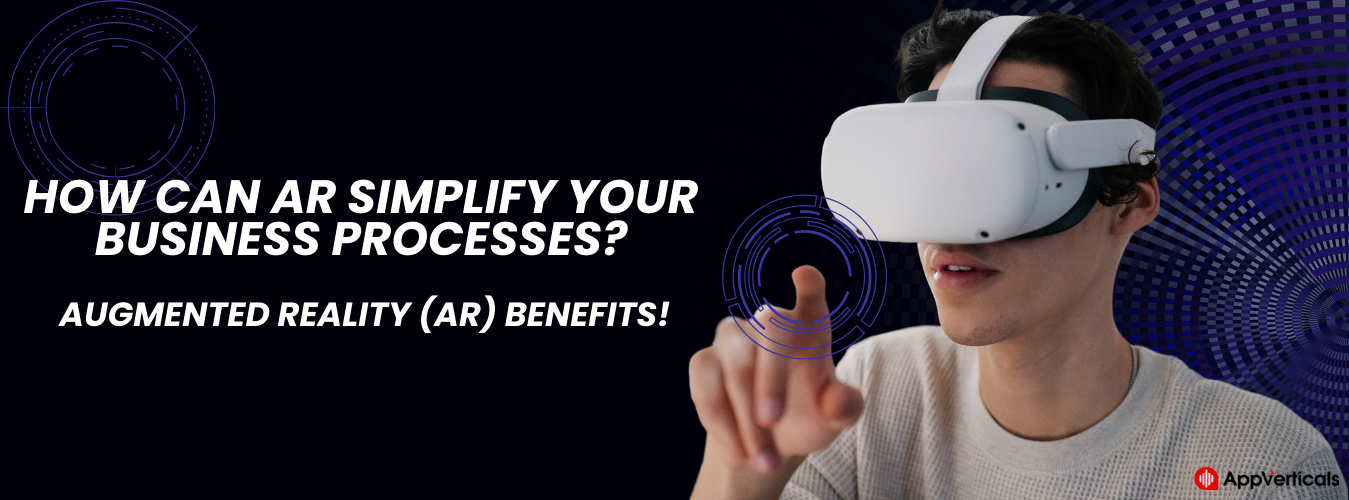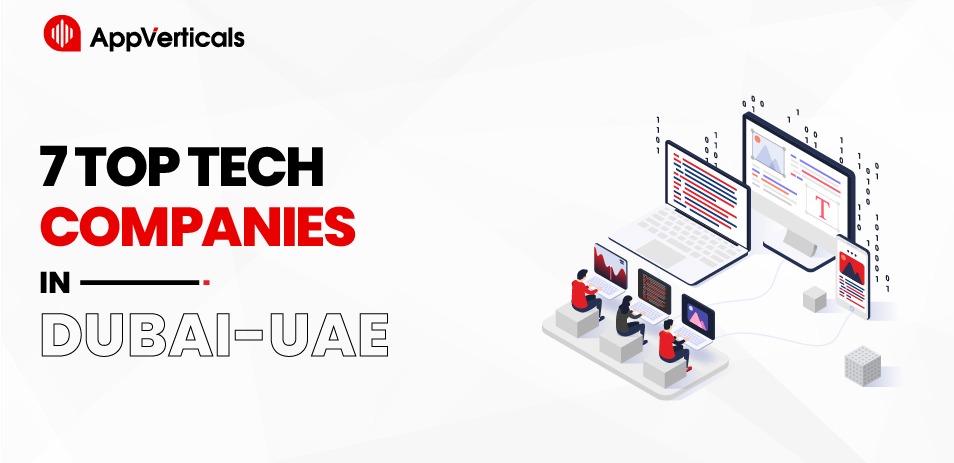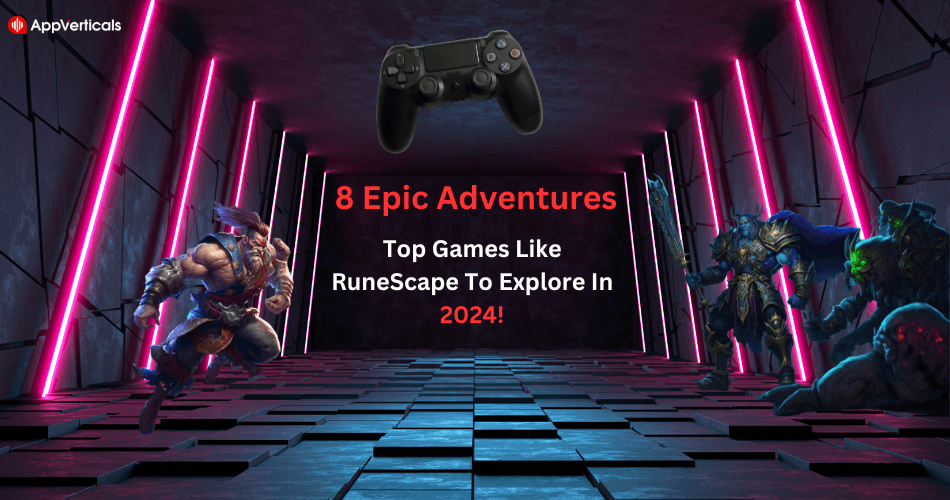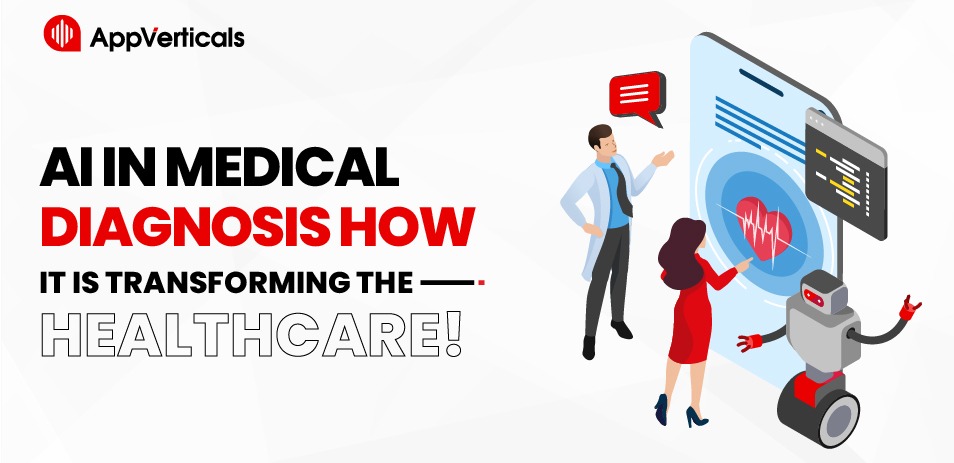Feeling swamped by paperwork? Drowning in data reports? Struggling to train new employees faster than a hummingbird’s wings? Fear not, fellow business warrior! There’s a new force in the land, poised to transform your processes and unleash your inner productivity Yoda: Augmented Reality (AR).
No, we’re not talking about catching virtual Pokémon Go critters in your office (although, how cool would that be for team building?). We’re talking about layering digital information onto the real world – think interactive blueprints floating above equipment or holographic step-by-step guides projected onto machinery.
Now, how can this fancy-sounding tech actually simplify your business processes?
Augmented Reality (AR) Top Stats
- Augmented Reality (AR) allows clients to see the finished design. Moreover, AR-enabled industrial tasks typically save 25% or more time.
- AR is lowering downtime costs and enhancing equipment efficacy through improved repair quality and resolution time. It has also decreased the need to travel to the site, but an expert is always available, albeit remotely.
- The ability to overlay 3D models generated from CT scans and MRIs on the surgical field during the surgery allows the surgical team to select the optimal points of entry and procedural approaches, reducing recovery time and improving patient outcomes.
- In 2023, 55% of corporations invested in AI, making the technology their top investment priority.
- According to a survey, 89% of executives report that their organizations are increasing their overall technology budget, which might be utilized to fund innovative tech ventures.
- Instagram users are the largest audience for branded Augmented Reality (AR) ads and filters. AR filter feature consumers utilize AR filters for an average of 75 seconds, which is four times longer than mobile video.
- As per Statista survey, consumers are looking forward to virtual reality or augmented reality while purchasing online.
Crafting Your Ideal Mobile App/Experience Starts Here!
Ready to elevate your business? Your custom app is just a click away.
Yes Let’s goAugmented Reality (AR) Best Practices: Real-World Examples That Will Blow Your Mind!
From fixing factories to furnishing living rooms, let’s blast off on a tour of the best industrial practices where AR is rewriting the rules:
1. Manufacturing: From Paper Jams to Productivity Jams:
Remember those mountains of manuals and cryptic schematics? Augmented Reality (AR) replaces them with holographic overlays that guide technicians step-by-step through repairs, like virtual Yoda whispering wisdom into their ears. AR cuts training time boosts retention, and unleashes confident, skilled employees like X-wings blasting through hyperspace.
Real-life example:
Boeing uses AR headsets to help technicians assemble complex aircraft components, reducing errors and speeding up production. The result? A quicker, smoother journey for those shiny new planes!
Practical Approaches for AR Implementation in Manufacturing
| Practice | Paper Jam Problem | AR Productivity Jam | Tips & Trends |
|---|---|---|---|
| Interactive Work Instructions | Bulky manuals, outdated info, confusing illustrations. | Holographic overlays guide steps, real-time updates, AI-powered troubleshooting. | Gesture-controlled interfaces, contextual information based on task and equipment. |
| Remote Assistance & Training | Expensive travel, limited expert availability, inefficient knowledge transfer. | Live AR guidance from experts anywhere, immersive simulations for trainees, 3D model annotations for remote collaboration. | AR glasses with shared views, gamified training modules, multi-user workspaces. |
| Quality Control & Defect Detection | Subjective assessments, human error, inefficient inspection processes. | AI-powered AR overlays highlight defects, automated data logging, real-time feedback for improvements. | Machine learning algorithms, advanced object recognition, predictive maintenance using AR data. |
| Warehouse & Logistics Optimization | Paper pick lists, confusing layouts, inefficient routes, manual inventory tracking. | Holographic navigation guides workers, AR labels track inventory in real-time, interactive dashboards for optimized workflows. | Voice-activated commands, wearable AR displays, smart beacons for location tracking. |
| Maintenance & Repair | Inaccessible equipment, unclear manuals, lack of specialized skills. | Holographic overlays guide repairs, step-by-step instructions with 3D models, remote assistance from specialists. | AR-based knowledge sharing platforms, AI-powered diagnostics, wearable AR displays for hands-free repairs. |
2. Retail: From “Can I try that on?” to “OMG, Try on EVERYTHING!”
Forget cramped dressing rooms and awkward “does this make me look…” questions. AR lets customers virtually try on clothes, see furniture materialize in their living rooms, and even test drive cars without leaving the showroom. AR creates personalized, interactive experiences that turn shoppers into brand ambassadors faster than you can say “swipe right.”
Real-life example:
The IKEA Place app lets customers see how furniture would look in their homes, reducing returns and boosting confidence in purchases. No more “honey, will this couch fit through the door?” drama!
Practical Approaches for AR Implementation in Retail
| Tip | Description | Latest Trend | Practical Approach |
|---|---|---|---|
| Virtual Try-On Everywhere | Let customers try on clothes, makeup, even glasses | AR mirrors in stores, & try-on apps. | Integrate try-on features into your existing app or website. |
| Interactive Product Visualization | Bring products to life with 3D models. | Holographic product displays, AR-powered furniture placement tools. | Use AR platforms with 3D model scanning capabilities, offer in-store demos and interactive experiences. |
| Enhanced Product Information | Overlay product details, reviews, and tutorials directly onto items via AR. | Scannable product labels, & smart shelves. | Develop custom AR overlays with rich information. |
| Gamified Shopping Experiences | Engage customers with AR treasure hunts, product quizzes, and interactive product demos. | Gamified AR scavenger hunts, product discovery games with rewards. | Design AR games, & offer incentives for participation. |
| Personalized Recommendations | Use AR to suggest products based on customer preferences and real-time behavior. | AR-powered “personal stylists,” context-aware product recommendations. | Leverage customer data and AI to personalize AR experiences, & offer exclusive promotions. |
| Immersive In-Store Navigation | Guide customers through stores with AR wayfinding arrows, highlight promotions, and offer virtual tours. | AR-powered maps and navigation overlays, interactive store displays. | Implement location-based AR experiences, and provide virtual tours. |
| Social Sharing and UGC | Encourage customers to share their AR experiences on social media, creating buzz and user-generated content. | AR filters and photo-sharing features, interactive social media campaigns. | Design shareable AR features, host contests and campaigns around user-generated AR content. |
| Virtual Shopping Events | Host live product demos, influencer showcases, and interactive events using AR. | AR-powered livestreams, virtual fashion shows, interactive product launches. | Partner with influencers and experts for AR-powered events, & offer virtual shopping experiences. |
| Measure and Adapt | Track user engagement and conversion rates for your AR initiatives to optimize future experiences. | A/B testing different AR features, analyzing user data and feedback. | Refine your AR offerings based on data and user preferences. |
3. Education: From Textbooks to Text Troopers:
Ditch the dusty textbooks and boring lectures. Augmented Reality (AR) lets students explore the pyramids in Egypt from their desks, dissect virtual frogs in biology class, or even travel back in time to witness historical events unfold. Augmented Reality (AR) turns learning into an immersive adventure, engaging students like never before.
Real-life example:
The New York Museum of Natural History uses AR to bring dinosaur skeletons to life, letting kids “interact” with these prehistoric giants. Learning paleontology has never been so Jurassic-ly awesome!
Practical Approaches for AR Implementation in Education
| Tip | Description | Latest Trend | Practical Approach |
|---|---|---|---|
| Engage All Senses | Go beyond visuals! Use AR audio, haptic feedback, and even smell to create immersive learning experiences. | Multimodal AR platforms, spatial audio technology. | Combine 3D models with sound effects, let students “touch” virtual objects, explore historical events with scent-based triggers. |
| Gamify the Learning | Turn learning into a quest! Award points, set challenges, and unlock rewards for mastering concepts with AR. | Adaptive learning features, gamified AR platforms. | Design AR scavenger hunts in science labs, let students battle historical figures in virtual duels, track progress and celebrate achievements. |
| Personalize the Journey | Cater to individual learning styles and paces. AR should adapt to each student’s needs. | AI-powered personalized learning, AR experiences with adjustable difficulty levels. | Develop AR activities with branching narratives, offer different learning paths based on student performance, allow them to explore topics at their own pace. |
| Make it Collaborative | Encourage teamwork and social interaction through AR experiences. | Multiplayer AR platforms, shared virtual environments. | Design AR projects where students collaborate to build virtual ecosystems, solve mysteries together in augmented crime scenes, or practice public speaking in front of virtual audiences. |
| Focus on Accessibility | Ensure everyone can participate, regardless of abilities. Offer alternative input methods and consider accessibility features in AR design. | Voice-controlled AR experiences, haptic feedback for visually impaired users. | Design AR experiences with multiple control options (touch, voice, gesture), provide audio descriptions for visuals, and consider spatial awareness for students with physical limitations. |
| Measure and Adapt | Track progress and refine your AR experiences based on data and feedback. | Learning analytics tools, user testing protocols. | Monitor student engagement with AR activities, collect feedback through surveys and interviews, use data to identify areas for improvement and iterate on your designs. |
4. Healthcare: From Band-Aids to Brainwaves:
AR is revolutionizing healthcare, from guiding surgeons during delicate procedures to helping patients overcome physical limitations. AR empowers healthcare professionals, delivers personalized care, and even boosts patient engagement in their well-being.
Real-life example:
AccuVein uses AR to help nurses find veins more easily, reducing painful needle sticks and improving patient comfort. No more poking around in the dark – AR brings veins to light!
Practical Approaches for AR Implementation in Healthcare
| Area | Best Practices | Latest Trends | Practical Tips |
|---|---|---|---|
| Surgical Training | * Holographic overlays guide surgeons during procedures. * AR simulations mimic actual operating rooms and patient conditions. | AI-powered feedback on surgical technique | Partner with medical schools and hospitals to develop realistic simulations. |
| Remote Consultations | * Doctors diagnose and treat patients virtually using AR-powered stethoscopes and medical scanners. * Specialists provide real-time guidance to on-site medical personnel. | Wearable AR devices for doctors and nurses | Invest in secure, HIPAA-compliant AR platforms for telemedicine. |
| Patient Education | * Interactive 3D models explain complex medical conditions and procedures. * AR apps track medication adherence and offer personalized health tips. | Gamified AR experiences to motivate patients | Collaborate with medical illustrators and healthcare professionals to create accurate and engaging AR content. |
| Physical Therapy and Rehabilitation | * AR games and exercises guide patients through recovery protocols. * Virtual environments simulate real-world scenarios for gait analysis and balance training. | Personalized AR exercise plans based on patient progress | Develop AR apps that integrate with wearable fitness trackers and other health monitoring devices. |
| Mental Health Therapy | * Virtual reality exposure therapy treats phobias and anxiety disorders. * AR mindfulness and meditation apps promote relaxation and stress reduction. | AI-powered chatbots for virtual therapy companions | Partner with mental health professionals to develop evidence-based AR therapy programs. |
| Drug Development and Research | * AR visualization tools analyze medical data and research results. * Holographic models simulate molecular interactions and drug mechanisms. | Collaborative AR platforms for research teams | Utilize AR to streamline clinical trials and drug discovery processes. |
5. Logistics: From Chaos to Cosmos:
Ever feel like your warehouse resembles a galactic junkyard? AR can streamline picking and packing tasks, guiding workers to the right items with holographic arrows and highlighting inventory levels in real time. AR transforms logistics into a well-oiled machine, boosting efficiency and saving businesses time and money.
Real-life example:
DHL uses AR glasses to help warehouse workers pick and pack orders faster and more accurately, optimizing their supply chain and delivering smiles (and packages) on time.
Practical Approaches for AR Implementation in Logistics
| Tip | Description | Latest Trend | Impact |
|---|---|---|---|
| Navigate Your Hyperspace Route | Implement AR-powered warehouse dashboards for real-time inventory tracking and route optimization. | AI-driven predictive analytics, holographic projections. | Increased efficiency, reduced errors, minimized delivery times. |
| Guide Your Droids | Equip pickers with AR glasses displaying holographic picking instructions and location overlays. | Voice-activated AR commands, gamified picking interfaces. | Improved picking accuracy, faster order fulfillment, boosted employee engagement. |
| See What’s Hidden | Utilize AR for remote assistance, allowing experts to guide technicians through repairs via holographic overlays. | AR-enabled smart glasses with real-time video streaming and annotations. | Reduced downtime, faster troubleshooting, expert support across locations. |
| Train Your Jedi | Employ interactive AR simulations for immersive warehouse training, covering safety procedures and equipment operation. | Gamified simulations with haptic feedback and multi-sensory experiences. | Improved employee skills, reduced safety risks, enhanced knowledge retention. |
| Paperless Paradise | Replace paper documents with AR overlays on packages, displaying shipping information, instructions, and tracking data. | Dynamically updated AR labels, customizable data visualization. | Streamlined workflows, reduced paperwork errors, improved visibility. |
| Speak the Droid Language | Integrate AR with barcode scanners and RFID tags for instant product recognition and data retrieval. | AR-powered barcode scanning with automatic data input and error correction. | Increased automation, faster processing times, minimized manual errors. |
| Augment Your Customers | Offer AR-powered product visualization before purchase, allowing customers to see furniture in their homes or try on clothes virtually. | Interactive 3D models, personalized AR experiences. | Enhanced customer engagement, reduced returns, improved buying confidence. |
| Deliver Delightful Experiences | Track packages with AR maps and visualizations, providing customers with real-time delivery updates and interactive tracking. | Holographic AR overlays on maps, personalized notifications with animations. | Increased customer satisfaction, transparency, and brand loyalty. |
6. Architecture and Design:
Augmented Reality (AR) lets architects and designers visualize projects in real time, collaborate with clients in immersive spaces, and even identify potential issues before construction begins. No more “Oops, the living room wall should be on the other side” scenarios.
Real-life example:
Skidmore, Owings & Merrill, a renowned architecture firm, uses AR to showcase building designs to clients, allowing them to virtually wander through proposed structures and provide feedback before construction starts. No more confusing 2D plans – it’s like stepping into the future!
Practical Approaches for AR Implementation in Architecture and Design
| Tip | Description | Latest Trend | Practical Approach |
|---|---|---|---|
| Immersive Collaboration | Bring clients and stakeholders into virtual designs with shared AR experiences. | VR/AR headsets for collaborative walkthroughs, real-time design adjustments. | Invest in portable VR/AR headsets for on-site demos, host remote client meetings in virtual models. |
| Interactive Prototyping | Test space layout, lighting, and materials before construction with AR overlays. | Scalable AR models, furniture placement tools, lighting simulations. | Create AR models of furniture and fixtures, allow clients to virtually “place” them in the space. |
| Enhanced Visualization | Overlay 3D models on existing spaces to visualize renovations or additions. | Augmented reality on tablets or smartphones, site-specific AR markers. | Develop AR apps for specific projects, use markers to trigger 3D model overlays on real-world locations. |
| Accessibility Insights | Simulate wheelchair movement or impaired vision within the AR model. | Accessibility-focused AR tools, simulated sensory experiences. | Partner with accessibility experts, utilize specialized AR tools for inclusive design. |
| Material Exploration | Explore different surface textures and finishes virtually within the AR model. | Material libraries with AR visualization, real-time color and texture testing. | Develop libraries of AR-enabled material samples, allow clients to “touch” and interact with virtual surfaces. |
| Construction Guidance | Use AR overlays on site to guide construction workers and avoid errors. | AR blueprints and instructions overlaid on real-world locations, holographic markers for precise positioning. | Integrate AR tools with construction workflows, train workers on using AR overlays for accuracy. |
| Marketing and Storytelling | Showcase your design expertise with interactive AR presentations and client experiences. | AR-powered brochures, virtual tours of completed projects, interactive demos in showrooms. | Create AR-enhanced marketing materials, develop interactive installations in your office or studio. |
| Stay Informed | Keep up with the latest AR tools and technologies relevant to architecture and design. | Industry conferences, workshops, online resources. | Attend AR-focused events, subscribe to industry publications, participate in online communities. |
7. Field Services:
Say goodbye to paper maps and cryptic directions. Augmented Reality (AR) can guide technicians to service locations with holographic arrows, overlay important repair information on equipment, and even provide step-by-step instructions through smart glasses.
Real-life example:
United Technologies Corporation uses AR headsets to help technicians troubleshoot complex machinery, reducing repair times and improving first-time fix rates. No more fumbling with manuals – AR brings the knowledge straight to their eyes!
Practical Approaches for AR Implementation in Field Services
| Tip | Description | Latest Trend | Practical Approach |
| Know Your Mission | Identify specific pain points AR can address: inefficient repairs, complex procedures, remote assistance needs. | AI-powered task analysis, data-driven decision-making. | Analyze service call data, interview technicians, evaluate task complexity. |
| Choose the Right Tool for the Job | Consider mobile apps, smart glasses, or headsets based on budget, task requirements, and user comfort. | Mixed reality (MR) blending real and virtual worlds, voice-activated AR interfaces. | Pilot test different technologies with technicians, assess cost-effectiveness. |
| Keep it Simple, Jedi | Design intuitive interfaces with minimal steps and familiar gestures. | Gamified training modules, holographic overlays for guidance. | Focus on essential information, avoid information overload. |
| Train Your Jedi (Technicians) | Provide thorough training on AR tools, workflows, and safety protocols. | Immersive AR simulations, microlearning modules for specific tasks. | Offer hands-on practice, encourage peer-to-peer learning. |
| Embrace Real-Time Data | Integrate AR with existing systems for instant access to manuals, diagrams, and customer information. | Cloud-based data platforms, remote expert assistance via AR. | Streamline workflows, ensure technicians have accurate information. |
| Make it Engaging, Not Eerie | Use interactive elements, 3D models, and gamification to keep technicians motivated. | Personalized learning paths, AR-powered performance dashboards. | Offer variety in tasks, track progress and celebrate achievements. |
| Gather Feedback and Adapt | Monitor performance, collect user feedback, and continuously improve your AR experience. | User surveys, performance analytics, A/B testing of different features. | Be open to adjustments, iterate based on real-world usage. |
| Remember, Safety First | Implement clear safety guidelines for using AR devices in different environments. | Voice-activated controls, haptic feedback features, visual alerts. | Train technicians on proper posture, situational awareness, and device-handling |
8. Marketing and Events:
Tired of bland brochures and static displays? AR lets you bring products to life, create interactive experiences at events, and even tell immersive brand stories. AR turns marketing into a multi-sensory playground, engaging audiences like never before.
Real-life example:
L’Oreal’s virtual lipstick try-on app lets customers experiment with different shades without leaving their homes, boosting engagement and driving sales. No more lipstick regret – AR enables you to find your perfect shade before you buy!
Practical Approaches for AR Implementation in Marketing and Events
| Tip | Description | Latest Trend | Practical Approach |
|---|---|---|---|
| Focus on Value, Not Gimmicks | Offer genuine benefits with your AR experience, not just flashy visuals. | Gamification, interactive product demos, educational content overlays. | Create AR games that teach about your product. |
| Tell a Story, Captivate Attention | Craft a compelling narrative around your AR experience to draw users in. | AR scavenger hunts, interactive product stories, immersive virtual environments. | Design an AR scavenger hunt at your events |
| Keep it Simple, User-Friendly | Make your AR experience easy to understand and navigate, even for tech novices. | Intuitive gestures, clear instructions, minimal information overload. | Use familiar gestures like taps and swipes, provide on-screen instructions, avoid cluttering the AR view. |
| Promote Strategically, Target Right | Use relevant channels to reach your target audience and generate excitement. | Social media AR filters, influencer partnerships, location-based campaigns. | Launch AR-powered contests on social media. |
| Measure and Refine, Learn and Grow | Track data to understand user engagement and optimize your AR experience. | Heatmaps, user feedback, click-through rates. | Monitor users interaction with your AR elements, and perform A/B testing. |
| Integrate Seamlessly, Enhance Reality | Make your AR experience complement your existing marketing and event activities. | AR product overlays on printed materials, interactive displays at booths, virtual try-on for physical products. | Use AR to bring printed materials to life, create interactive displays that connect to your app. |
| Think Beyond Technology, Focus on the Human Experience | Remember, AR is a tool, not the main event. Focus on creating a memorable and engaging experience for your audience. | Personalization elements, emotional connections, storytelling power. | Use AR to personalize experiences for visitors, create moments of emotional connection |
9. Sports and Entertainment:
Want to feel like you’re running alongside Usain Bolt or scoring a goal with Messi? AR lets you train alongside Olympic athletes through virtual simulations, attend concerts from your living room, and even interact with your favorite characters in real time. AR blurs the lines between reality and entertainment, creating experiences that are out of this world.
Real-life example:
The NBA used AR technology during the 2020 playoffs to project virtual fans onto empty seats, creating a more engaging atmosphere for players and viewers alike. No more cardboard cutouts – AR brings the crowd roaring back!
Practical Approaches for AR Implementation in Sports and Entertainment
| Tip | Description | Latest Trend | Practical Approach |
|---|---|---|---|
| Immersive Fan Experiences | Take fans beyond the bleachers with AR overlays on fields, courts, and arenas. | Virtual mascots, interactive replays, gamified challenges. | Partner with broadcasters to offer AR-enhanced viewing experiences. |
| Virtual Try-On & Merchandise | Let fans virtually try on jerseys, equipment, or even experience VIP club lounges. | Holographic fitting rooms, AR product demonstrations. | Create interactive try-on apps for team merchandise. |
| Interactive Training & Performance | Enhance athlete training with AR simulations and data visualization. | Overlays for plays and tactics, holographic opponents for practice. | Develop AR training modules for athletes. |
| AR-Powered Scavenger Hunts & Events | Engage fans with interactive AR treasure hunts and gamified experiences. | Location-based AR games, AR-triggered challenges at live events. | Create themed AR scavenger hunts around stadiums, offer AR-activated challenges during halftime shows. |
| Social Media & Sharing | Encourage fan-generated content and virality with AR filters and challenges. | Branded AR filters for photos and videos, shareable AR experiences. | Develop unique AR filters for social media platforms, host AR-powered contests and hashtag campaigns. |
| Data-Driven Optimization | Track user engagement and performance of AR features to continuously improve. | Heatmaps of AR hotspots, analytics on user interactions. | Monitor user behavior within AR experiences. |
| Partner with AR Experts | Find the right AR development partner to ensure seamless integration and success. | Experienced AR design and development teams, industry knowledge. | Collaborate with companies to craft bespoke AR experiences tailored to your specific needs. |
| Focus on Storytelling & Engagement | Don’t just add AR, weave it into a compelling narrative that captivates fans. | AR-triggered character interactions, interactive storylines. | Develop AR experiences that enhance existing narratives. |
| Remember, Ethics Matter | Respect user privacy, avoid intrusive AR experiences, and prioritize accessibility. | Clear opt-in/out options, responsible data collection practices. | Ensure user consent for AR features, offer alternative experiences for non-AR users. |
10. Travel and Tourism:
Ditch the bulky guidebooks and confusing maps. AR can overlay historical information onto landmarks, translate foreign languages in real time, and even guide you through hidden gems like a local tour guide. AR transforms travel into a personalized, interactive adventure, opening up the world like never before.
Real-life example:
Marriott Hotels uses AR glasses to provide guests with information about hotel amenities, local attractions, and historical landmarks, offering a self-guided and immersive experience. No more wondering where the pool is – AR points you in the right direction!
Practical Approaches for AR Implementation in Travel and Tourism
| Tip | Description | Latest Trend | Practical Approach |
|---|---|---|---|
| Unleash Immersive Previews | Give travelers a virtual taste of your destinations before they book. | Hyper-realistic 360° tours, cityscapes augmented with points of interest. | Partner with local attractions, showcase iconic landmarks with AR overlays, offer interactive previews of hotels and rooms. |
| Enhance Destination Navigation | Make exploring cities and attractions seamless with AR wayfinding and overlays. | Interactive maps on smartphones, AR arrows guiding users to points of interest. | Integrate AR maps with existing tourism apps, provide turn-by-turn directions with overlaid landmarks. |
| Bring History to Life | Reimagine historical sites and events through interactive AR storytelling. | Virtual tours of ancient ruins, AR recreations of historical battles or cultural performances. | Partner with museums and historical sites, develop AR experiences that bring exhibits to life with animation and narration. |
| Make Learning Fun and Accessible | Transform language barriers and complex information with AR translation and explanation. | Real-time AR translation of menus or signs, interactive overlays explaining exhibits or historical sites. | Integrate AR translation apps with tourist attractions, develop AR overlays that simplify complex information using visuals and audio. |
| Boost Accessibility and Inclusivity | Ensure everyone can enjoy AR experiences, regardless of limitations. | Audio descriptions for visually impaired users, AR interfaces designed for different abilities. | Partner with accessibility organizations, offer alternative ways to interact with AR experiences besides visual cues. |
| Don’t Forget the Fun Factor | Inject some playful magic into your AR offerings to keep travelers engaged. | Interactive photo filters with local themes, AR games at airport lounges or cultural events. | Design entertaining AR filters for social media, develop interactive games that introduce local folklore or traditions. |
AR Revolution in Your Business: From Zero to Hero in 5 Steps
Remember those clunky headsets and grainy graphics of “augmented reality” from yesteryear? Forget it! Today, AR is about to revolutionize your business – not with spooky ghosts or virtual Pokemon, but with real-world benefits that’ll blow your mind (and boost your bottom line).
But where do you begin? Don’t worry, fellow business adventurer! This guide will equip you with a lightsaber-sharp plan to integrate AR into your operations, step-by-step, and blast you into the next galaxy of success.
Step 1: Find Your AR Force – Identify Your Needs:
Before jumping into the AR vortex, grab your metaphorical map and figure out your destination. Ask yourself:
- What are your biggest pain points? Are you drowning in training manuals? Do customers need help visualizing products? Is efficiency a galactic monster you can’t tame?
- Which departments could benefit most? Marketing, manufacturing, logistics, training – AR has superpowers for everyone.
- What are your budget and resources? Don’t worry! AR comes in all shapes and sizes, from simple smartphone apps to high-tech headsets.
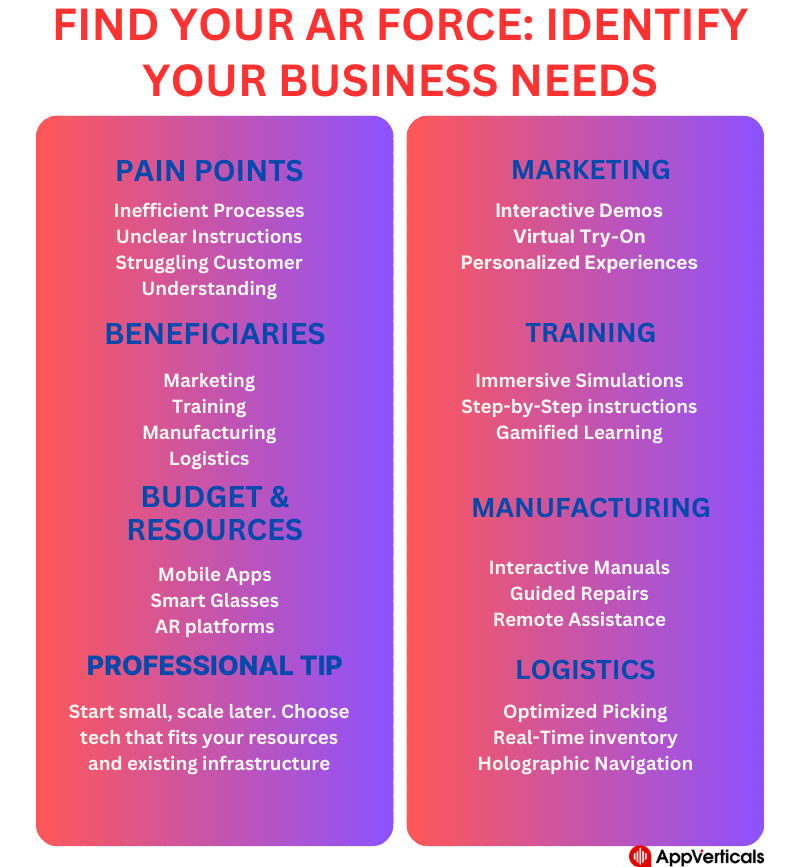
Step 2: Research and Choose the Right Tech:
Now, it’s time to arm yourself with the right tools! Explore the AR universe:
- Mobile apps: Easy to use, widely available, and perfect for customer-facing experiences or interactive training.
- Smart glasses: Hands-free, immersive, and ideal for field services, maintenance, or remote assistance.
- AR platforms and engines: For complex applications and custom AR experiences, these offer more flexibility but require technical expertise.
Remember, the best tech is the one that seamlessly integrates with your existing infrastructure and workflows. No need to build a spaceship if a trusty speeder bike gets you there!
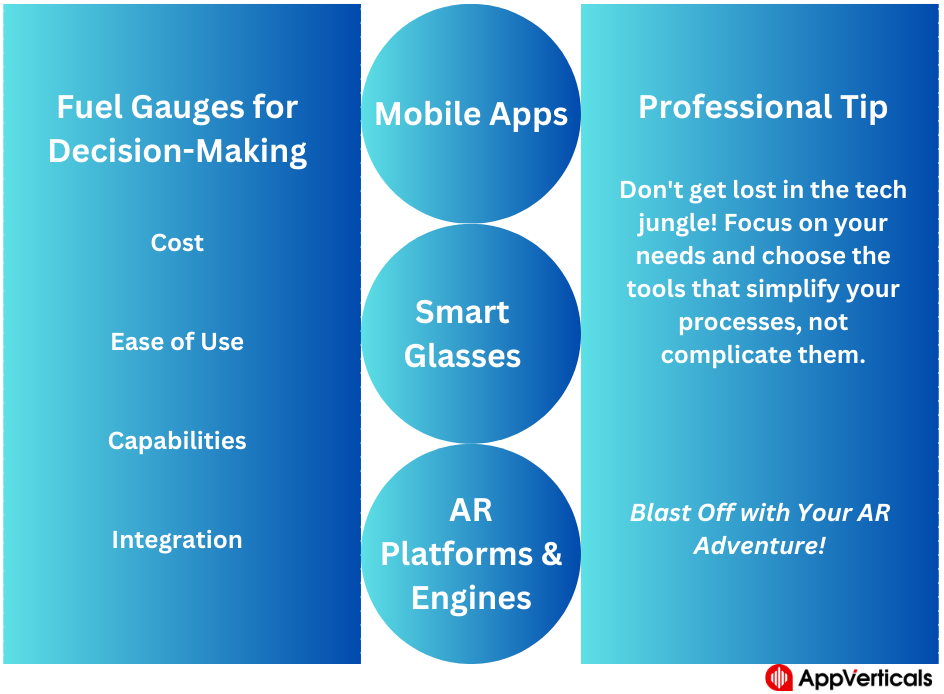
Step 3: Build Your Death Star – Design Your AR Experience:
It’s time to unleash your inner Yoda and craft a compelling Augmented Reality (AR) experience. Think like a storyteller:
- Start with a clear goal: What do you want your AR to achieve? Boost sales, enhance training, improve efficiency? Keep your focus sharp.
- Design for simplicity: Think intuitive interfaces familiar gestures, and avoid overwhelming users with information overload.
- Make it visually engaging: Stunning graphics, interactive elements, and a touch of gamification can turn your AR experience into a galactic joyride.
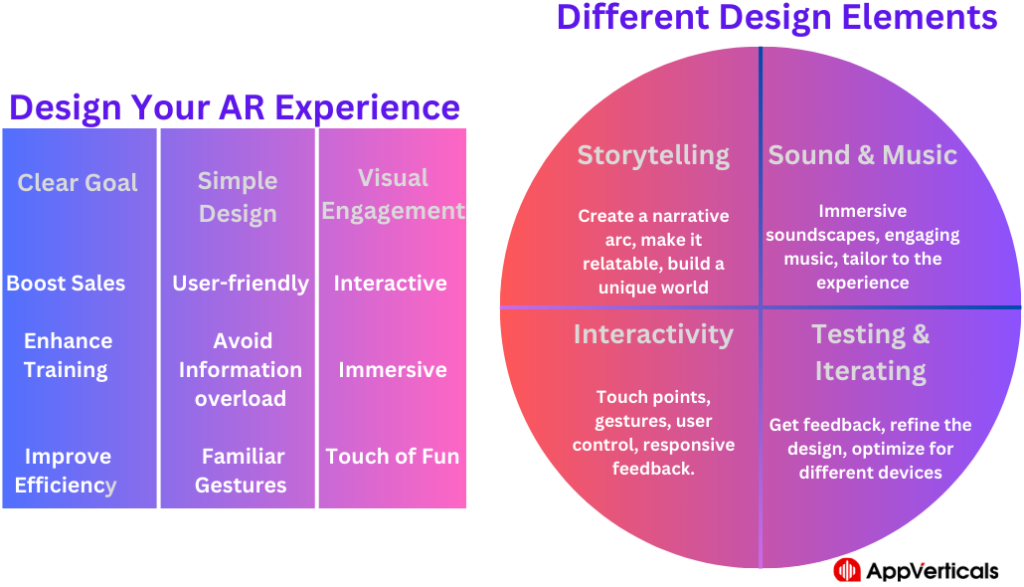
Step 4: Test, Tweak, and Triumph – Pilot and Evaluate:
Before unleashing your AR masterpiece on the world, gather your trusted rebel squad for a test run. Get feedback, identify glitches, and refine your experience until it’s smoother than a Millennium Falcon landing.
This iterative approach ensures your AR isn’t just another droid left to rust in the desert. Remember, even Yoda needed to hone his lightsaber skills!
| Phase | Key Action | Latest Info & Tips | Catchy Phrase |
|---|---|---|---|
| Pre-Launch | Define success metrics | Align goals with measurable KPIs (sales, engagement, training scores) | Aim for the Kessel Run record! Set clear goals. |
| Recruit test pilots | Find diverse users who represent your target audience | Assemble your rebel squad! Get real-world feedback. | |
| Develop a testing script | Plan scenarios to cover key features and potential issues | Chart your course! Have a structured testing plan. | |
| Testing | Observe user behavior | Watch how users interact, note pain points and areas of delight | Become a Jedi Master of observation! See how your AR flows. |
| Collect feedback & data | Use surveys, interviews, and analytics to gather quantitative & qualitative data | Listen to the Force! Feedback is your lightsaber. | |
| Analyze results & identify issues | Pinpoint technical glitches, confusing workflows, and areas for improvement | Face the Dark Side! Confront problems head-on. | |
| Tweaking | Prioritize fixes based on impact & feasibility | Address critical issues first, consider future updates for less impactful ones | Refine your Death Star! Make improvements step-by-step. |
| Iterate and release updates | Quickly implement fixes and improvements based on testing data | Embrace the iterative Force! Continuous improvement is key. | |
| Evaluation | Track post-launch performance | Monitor KPIs, compare data to pre-launch metrics, and measure impact | Did you reach hyperspace? See if your AR is a success! |
| Share results internally & externally | Showcase the value of AR, celebrate learnings, and inspire future projects | Spread the AR gospel! Share your success story. |
Step 5: Spread the Force – Launch and Promote Your AR Experience:
It’s time to showcase your Augmented Reality (AR) creation to the galaxy!
- Train your employees: Make sure they understand the AR experience and can guide customers or troubleshoot issues.
- Promote it to your target audience: Use social media, email campaigns, or even in-store demos to pique your audience’s curiosity.
- Track your results: Analyze data to see how your AR experience is performing and make adjustments as needed. Remember, even the Death Star needed a thermal exhaust port for improvement!
Crafting Your Ideal Mobile App/Experience Starts Here!
Ready to elevate your business? Your custom app is just a click away.
Yes Let’s goBenefits That Blast Through the Galaxy:
These are just a few ways AR can simplify your business processes. But the best part? The benefits go beyond mere simplification. They touch every corner of your organization, like a lightsaber illuminating the darkness:
- Increased Efficiency: AR saves time, reduces errors, and streamlines workflows, boosting productivity and output like a well-calibrated engine.
- Improved Accuracy: Forget human error; AR overlays ensure precision and eliminate guesswork, leading to flawless execution and happy customers.
- Enhanced Training: Immersive AR simulations accelerate learning, increase knowledge retention, and create a generation of confident, skilled employees.
- Reduced Costs: From less downtime to faster training, AR cuts operational costs and improves your bottom line like a wise accountant wielding a budget spreadsheet.
- Happy Customers: Personalized, interactive experiences build brand loyalty and turn customers into evangelists, spreading your galactic business empire far and wide.
Wrapping it Up!
Augmented Reality (AR) is the future, and it’s here to stay. By embracing this transformative technology, you can simplify your processes, boost efficiency, and leave your competitors frozen in carbonite. Remember, in the business world, speed and agility are your X-wings, and Augmented Reality (AR) is your hyperdrive. So, take the leap, embrace the AR revolution, and let your business journey through the galaxy to success!
Need more help? Contact us! We are here to help.

